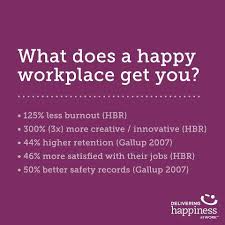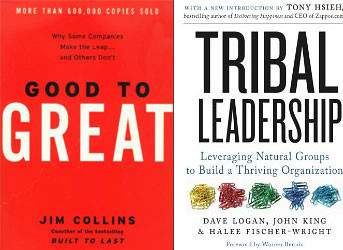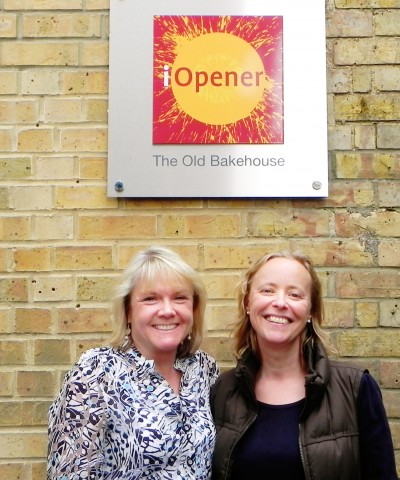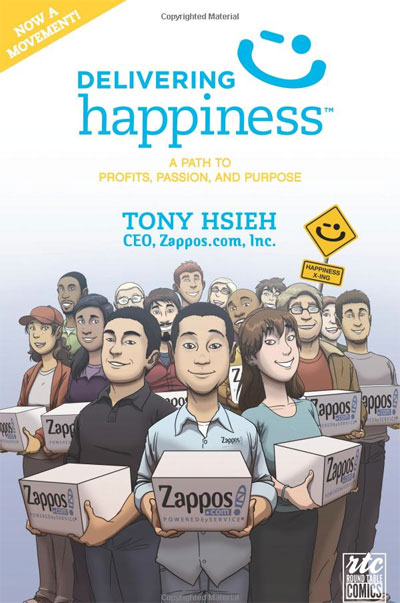
Let’s pretend you’ve been given carte blanche to design the company of your dreams. What would that company look like? How would you do things differently? Why would your employees look forward to starting work each day?
You already know creating a happy workplace isn’t just about Casual Fridays and big paychecks. And the reasons for its importance go way beyond the individual. Companies are discovering that if they want to thrive, if they want productivity to soar, they need to invest in their human capital.
New research by the Hay Group reinforces this concept. Companies with highly engaged employees experience four times the revenue growth, 54% higher employee retention rates and 89% greater customer satisfaction than companies whose employees are not emotionally connected to the organization. And those engaged employees are 50% more likely to transcend their leaders’ expectations.
How do you create an environment that inspires this kind of firecracker enthusiasm? Rob Goffee and Gareth Jones have spent the last three years trying to answer that question. After surveying hundreds of executives around the world, they published their findings on the alchemy of the ideal workplace in the May 2013 Harvard Business Review.
Goffee and Jones identified six common practices of authentic, happy organizations. These companies:
1) Nurture individuality. According to research conducted by London Business School Professor Dan Cable, when employees feel free to be completely themselves at work, they are more dedicated, perform at higher levels and happily lend a helping hand to their peers. This inclusivity extends beyond conventional categories of race, age and gender to embrace intellectual diversity and personal eccentricities. There are no cultish cliques, bosses’ pets, pressures to conform or feelings of inequity. Ideas flourish in this multidisciplinary melting pot where English majors hang with accountants, artists with engineers and jocks with the IT crowd.
2) Practice open, honest communication. There is no trust without transparency, and authentic happiness requires a shared level of trust among all members of an organization. Don’t patronize your staff—empower them with knowledge. The more they understand—even when the news appears bad—the more potential solutions they can offer. And suppose you’re a branch office of a larger organization. Keep the corporate information flowing—even if it seems to change willy-nilly. You can create a culture of “We’re all in this together.”
3) Encourage employee development. Create the time and resources for people to pursue their passions. This goes deeper than skill-building, educational opportunities and professional development, although those are important. Maybe an employee has a yearning to take up graphic design, Spanish or creative writing. Even if the subject isn’t obviously related to their job, they may discover a hidden strength that, if nurtured, could end up benefiting the organization in unexpected ways. By awakening and developing these talents, the company not only helps the employee become a richer human being, but that employee may evolve to fill a new institutional role that enriches the overall organization.
4) Serve a meaningful purpose. Employees who feel part of a larger cause and who know their organization is making a difference in the world will wake early, stay late and work through lunch to help achieve that collective purpose. Their lives will be imbued with a meaning driven by the quest for a greater good, and they will be proud to share your company’s mission with others.
5) Offer work that is rewarding in itself. Rewrite job descriptions to focus on each person’s strengths and assign projects that allow employees to flex their creative muscles. Budding videographers can film commercials; short-story writers can compose marketing copy; comic book artists can design the company handbook. Keep inspiration flowing, and the organization will become a hotbed of innovation.
6) Don’t make employees follow mindless rules. In the 1999 comedy Office Space, about five different bosses chastise the protagonist for forgetting to put the new coversheet on his TSP reports. This has become iconic for the arbitrary busywork and “just-because” rules companies force their employees to follow. Pointless tasks breed resentment and dread—pretty much the last feelings you would expect to find in the happiest workplace on earth.

Goffee and Jones conclude, “People want to do good work—to feel they matter in an organization that makes a difference. They want to work in a place that magnifies their strengths, not their weaknesses.”
Makes sense, doesn’t it? And yet traditional, profit-driven business culture fails to cultivate its most valuable resource: employees. Creating a happy workplace is a win-win for the staff and the company. It’s time for our business models to reflect this growing, research-driven awareness.
Do these six principles describe your dream organization? Are there other characteristics you would add to this list? I’d love to hear about your experiences with positive workplaces.
For more about the benefits of happy workplaces, see my previous posts:
A New Report on Workplace Happiness
Is Your Work a Test of Endurance or a Labor of Love?
Learning About Happiness and Company Culture from the Big Dogs
Why Happiness at Work Trumps Employee Engagement and Job Satisfaction
Is Anyone Sick of Happiness of Work? I’m Not, and Here’s Why
The Value of Happiness: How Employee Well-Being Drives Profits
Is Happiness a Luxury Small Businesses Can’t Afford?
Wall Street Journal Measuring Happiness at Work
If Happiness Drives Performance, How Do I Get Happy at Work?


 Did you know rudeness at work is raging and is on the rise? According to researchers, 98 percent of workers polled said they experienced rudeness at work—with half of them experiencing it at least once a week, up from 25 percent in 1998.
Did you know rudeness at work is raging and is on the rise? According to researchers, 98 percent of workers polled said they experienced rudeness at work—with half of them experiencing it at least once a week, up from 25 percent in 1998. And keep a pulse on the organization. What’s really going on, and how are people treated and treating others? You need to be connected to your workforce and constantly striving to create a culture where people feel as though they have what’s needed to succeed.
And keep a pulse on the organization. What’s really going on, and how are people treated and treating others? You need to be connected to your workforce and constantly striving to create a culture where people feel as though they have what’s needed to succeed.
 You will also be asking all your constituents to weigh in on what defines your company DNA. This means clients, subcontractors, other design team members, and influencers. Asking and listening to your constituents (and employees) is a natural way to build trust and take your relationship to the next level. This is marketing and management brilliance.
You will also be asking all your constituents to weigh in on what defines your company DNA. This means clients, subcontractors, other design team members, and influencers. Asking and listening to your constituents (and employees) is a natural way to build trust and take your relationship to the next level. This is marketing and management brilliance. The realization that happy workers drive business success is sweeping the world, and the research keeps growing. Researchers at
The realization that happy workers drive business success is sweeping the world, and the research keeps growing. Researchers at 
 This is about staying resilient and motivated enough to maintain productivity levels. Our data shows resilience hasn’t taken a knock over the past few years, but motivation has. It dropped by 23% during 2010 and climbed back by 17% during 2011, but there has been no improvement in 2012.
This is about staying resilient and motivated enough to maintain productivity levels. Our data shows resilience hasn’t taken a knock over the past few years, but motivation has. It dropped by 23% during 2010 and climbed back by 17% during 2011, but there has been no improvement in 2012. Driver 5: Self-Belief
Driver 5: Self-Belief






